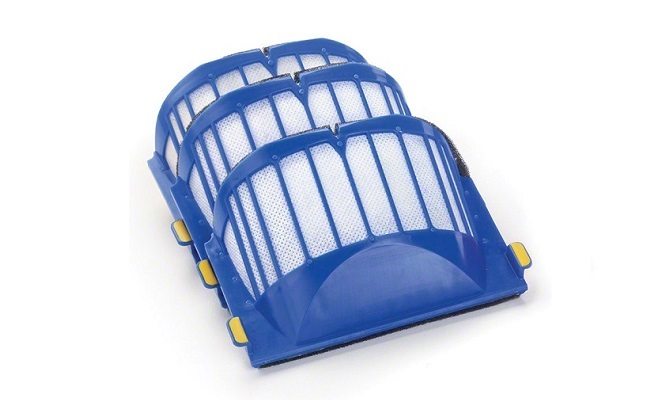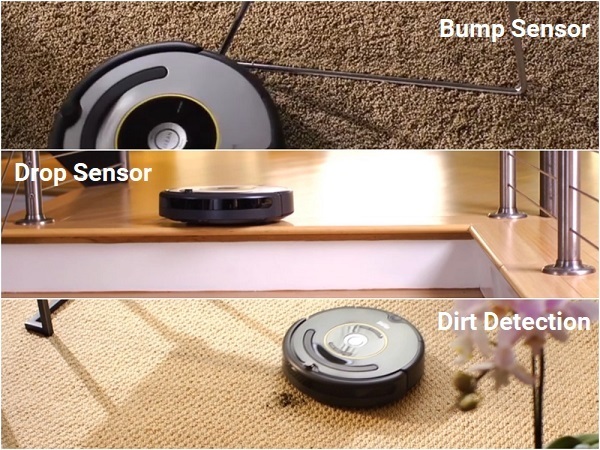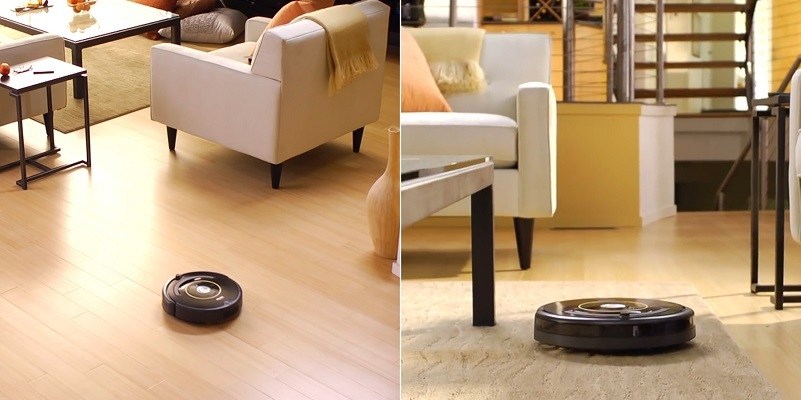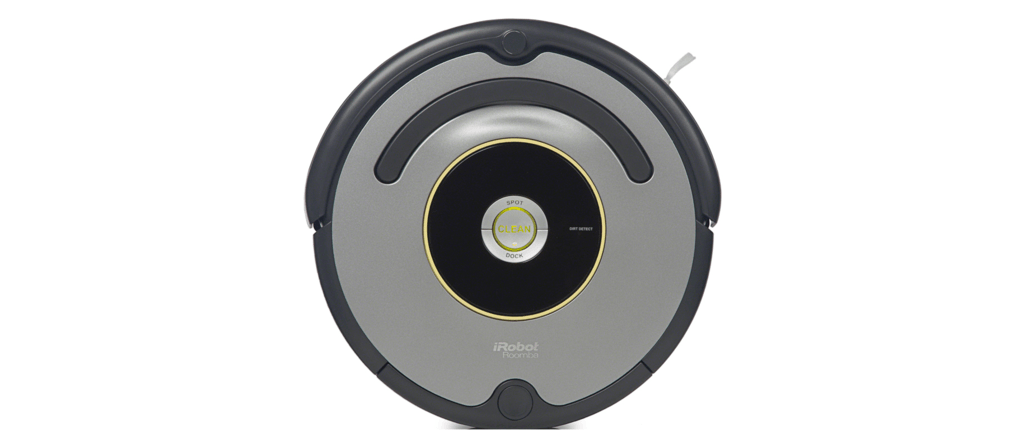Yet another entry in the Roomba class that is quickly becoming the best budget-friendly line-ups in the industry, the Roomba 618 gives you a clean you can trust without a lot of extras to get in the way. Depending on your specific needs and preferences the 618 could be the perfect model for you.
Whether it is or not remains to be seen, and is the purpose of this review. We will examine the inner workings of the robot vacuum in a simple break down format that will help you decide one way or the other. We will even offer alternative options for you if you decide the Roomba 618 isn’t right for you.
Contents
Who the Roomba 618 is for
The Roomba line offers many choices for various situations, homes and circumstances. You will find that the Roomba 618 fits well within your home if:
- You have a small to medium-sized floor plan.
- You don’t need to use mobile apps or voice commands.
- You want a robot that will keep up on daily messes between regular cleanings with your upright.
Who the Roomba 618 is not for
Not everyone will find the Roomba 618 useful or helpful in their particular situations. You may be among this group if you:
- Have a larger floor plan with a lot of furniture or objects on the floor.
- Require scheduling of the robot for cleaning cycles.
- Have allergies to the common in-home allergens such as pollen and pet dander.
Breaking Down the Roomba 618
Let’s get into the meat of the machine here and look at the prominent features. I will explain the important aspects of the 618 in order to help you decide if the purchase is right for you.
The Filtration Isn’t Up to Current Standards
Currently, the standard for most models is to have HEPA quality filtration. While this isn’t an industry standard, it is expected in most cases. However, the 600 series was released before iRobot moved on to their high-efficiency filters.

The 618 uses the standard AeroVac filter, which will capture particles down to 10 microns in size. This isn’t good enough to capture all the in-home allergens such as dust mites, pet dander, pollen and mold.
This, in itself, is enough for some people to begin looking at other models. However, before you leave let me remind you that robotic vacuums aren’t designed to replace your regular cleanings with the more powerful upright vacuum that should have a HEPA quality filter.
Unless you do not have an upright vacuum or your upright doesn’t have a HEPA filter, then you shouldn’t be too concerned with the filter on your robot. The main purpose of these filters is to keep the motor area clear of dust and debris, and in that aspect, the filter on the 618 does its job.
The Battery, Like the Filter, Leaves a Little to be Desired
The battery on the 618 is the same as it is on most other 600 series models. The 1800mAh lithium-ion battery will power the robot for up to 60 minutes at a time. When the battery runs low the robot will recharge the battery on its own.
As the robot runs around the home cleaning, it will monitor the battery level. When the charge falls below 15%, the 618 will stop the cleaning cycle and begin making its way back to the charging dock.
The recharging cycle will take about three full hours to complete at which time you will have to restart if the job didn’t get complete manually. How far will a single charge take the 618? On hard flooring only (which is what all the tests are done on in the lab) you can expect to have about 1100 square feet of floor space clean.
If you mix in carpeting and rugs, that number will fall to about 900 square feet. Depending on the size of your home, this may be enough for the vacuum to clean the entire floor space on a single charge.
However, there are other factors to consider as well such as the amount of furniture and items on the floor that the 618 will have to maneuver around. The more table and chair legs there are, the longer it will take the robot to get around and clean between them. This is also the case for the size and layout of the individual rooms.
All in all, most floor plans should plan on a couple of cleaning cycles to get every square foot covered. We will cover the navigation and reasoning behind this limitation later on in the article. However, as far as the battery is concerned, just note that for most homes over 900 square feet in size you should expect to have to run the robot daily to cover the whole space.
The Limited Controls Are One of the Reasons The Price Remains Low
Budget-friendly models usually have quite a few features that are missing or lacking in the more expensive models. This is just one of the things we, as consumers, have come to expect and accept.
In the case of the 618, one such feature is the control options. Technology has made it easy for robotics to use wireless communications. In the case of robotic vacuums, this means they have the capability to be controlled by mobile apps and voice commands through Amazon Alexa or Google Assistant enabled devices.
The trade-off is a higher price tag. This is to offset the cost of the necessary components, the building and maintaining of the mobile apps and future updates and advancements. When the manufacturer wants to save money and lower the cost of their robots, this entire process is removed from the equation.
This means that models, like the Roomba 618 don’t have these features. Instead, you are left with local controls only. This does simplify things as you aren’t required to have a wireless network in your home, a smartphone or fancy devices that recognize your voice.
[easyazon_image align=”center” height=”500″ identifier=”B01NBIVPY7″ locale=”US” src=”https://smartrobotichome.com/wp-content/uploads/2019/06/51dpljbJEXL.jpg” tag=”srh-easyazon-20″ width=”500″]The local controls themselves are also quite simple. There are three buttons to choose from. The large, central button, is labeled “clean” and will do just what it sounds like. The first time you press the clean button, the robot will wake up. The second press of the button will send the robot out to clean the floors.
Below the clean button is the dock button. This button will send the 618 back to the charging station, ending the cleaning cycle and starting the recharging cycle. You should note that you will need to first press the clean button once to pause the robot before it accepts the dock button instruction.
The third and final button is the spot clean button. This is found above the clean button and will make the 618 perform a spot clean. A spot clean is a simple clean that will only affect a small area of the floor. You will need to carry the robot to the spot that you want to be cleaned and then press the spot clean button.
When you do press the button the robot will start cleaning while moving in an outward spiral to a diameter of about three feet from the original starting point. When the spot clean is complete the robot will stop and await further instructions.
Sensor-based navigation is not as outdated as you may think. Even with laser-guided mapping and camera-based navigation robots on the market, the majority still use infrared and acoustic sensors for their navigation needs.
The Roomba 618 uses three different types of sensors to navigate your home and protect itself and your belongings from damage. The three sensors are drop sensors, bump sensors and dirt detection sensors.

The drop sensors are located on the bottom of the robot and send out an infrared beam to detect how far the floor is from the robot body. If the sensor detects the floor is greater than an inch and a half (rough estimate), the 618 will stop and change direction.
These sensors keep the robot on level ground and protect it from falling off ledges or tumbling down stairs. Most thresholds in doorways will be navigated with ease and the robot can climb over ledges that are a half inch or less in height. Any more than this and the Roomba will see the threshold as a ledge and avoid the area completely.
The bump sensors are a mixture of acoustic and infrared sensors that keep the robot from crashing into walls and furniture legs. The acoustic sensors detect when an obstacle is coming up and the robot will slow down the approach.
The infrared sensors then kick in to alert the robot about the distance to the obstacle. As the robot approaches, it will nudge the obstacle. If it is solid, such as a wall or table leg, the robot will begin moving back and forth to attempt to get around the blockade.
If the obstacle is soft and passable, such as curtains or bed skirts, the 618 will push forward and continue cleaning.
Finally, the 618 has dirt detection sensors. These infrared sensors basically work along with the brush rolls to detect when the dirt, dust and debris are gone. As long as the sensors detect particles in the general area, the robot will come back to the spot in crisscross movements until the sensors report that the area is clear.
There isn’t a Mapping Feature or Human-Like Cleaning Patterns
Without a camera like the Roomba 960, the 618 has no real idea where it has been or where it has left to clean. It will basically use a pseudo-random cleaning pattern until you either stop the cleaning cycle, or the battery needs to be recharged.
Since the vacuum doesn’t create a map of your home, it will not be able to resume cleaning after the battery has been charged. You will also notice that there are areas of the floor that don’t get cleaned as well (or at all) with every outing.
However, the Roomba 618 won’t use the same path when cleaning your home. What this means for you is that you will need to run a cleaning cycle daily. Doing so will ensure that the entire floor space will get cleaned a minimum of twice a week.
While the first run may miss a section of flooring, that section will be cleaned on the second outing. It is important to note, though, that this doesn’t mean large areas of flooring will be missed, but if you are watching, you will be able to see some areas don’t get covered as often as others during a particular outing.
Specifications Chart
Now that the major features are covered let’s take a look at all of the features that are (or are not) included with the Roomba 618.
| Roomba 618 | |
| Dimensions | 13.7×13.7×3.6 inches |
| Weight | 7.9 pounds |
| Battery | 1800mAh Lithium-Ion |
| Runtime | Up to 60 minutes |
| Recharge Time | 3 hours |
| Automatic Recharge | Yes |
| Navigation | iAdapt |
| Drop Sensors | Yes |
| Bump Sensors | Yes |
| Dirt Detection Sensors | Yes |
| Filtration | AeroVac Standard |
| Spot Clean Mode | Yes |
| Edge Clean Mode | No |
| Side Brushes | 1 |
| Cleaning Method | 3-stage with dual brush bars |
| Wireless Communications | No |
| Mobile App | No |
| Voice Control | No |
| Local Control | Yes |
| Scheduling | No |
| Containment | Virtual Wall Barrier (Separate Purchase) |
| Warranty | 1 Year |
| Price | Check on Amazon |
Alternative Options
In case you can’t decide if the 618 is for you or not, or perhaps you want other options to compare the Roomba model to, here are a few alternatives to keep in mind.
Roomba 650
The Roomba 650 is near identical to the 618 except two small features. First, the 650 comes with a virtual wall containment barrier. This is not included in the purchase price of the 618. The other difference is that you can schedule cleaning cycles up to seven days in advance on the 650.
Both models are otherwise the same and come with the same filtration, sensor-based navigation and average runtimes.
See what customers say about the Roomba 650 on Amazon.
Neato D3 Connected
The Neato Connected series come with wireless communications to enable mobile app control and voice commands through Amazon Alexa or Google Assistant devices. The major difference, though, is that the D3 Connected uses laser-guided navigation. This will allow the robot to map your home, resume cleaning after a battery charge and clean in parallel, human-like patterns.
The D3 is the first entry in the connected line series and is currently one of the most affordable models from Neato.
See what people say about the Neato D3 Connected on Amazon.
Eufy Robovac 11+
The Robovac 11+ from Eufy is a simple yet powerful machine that has a few extra features over the 618. For starters, it has a HEPA quality filter that will capture particles down to three microns in size. This will eliminate up to 99 percent of in-home allergens to help you breathe easier.
The 11+ also boasts a longer runtime over the 618 (90 minutes total) as well as an infrared remote control in addition to the local control options. You will pay a little more, but for some, these slight upgrades are worth the cost.
See the Eufy Robovac 11+ on Amazon.
Frequently Asked Questions
I will now answer some of the more common questions surrounding the Roomba 618. If you have more questions or remarks, please feel free to use the comment section below.
Q. What types of floors is the Roomba 618 rated to clean?

A. The short answer is all floor types. While this isn’t technically wrong, there are some floorings that you should watch closely when cleaning with the 618.
Hard flooring of all types will be cleaned by the 618. However, if you have softwood floors (such as pine) or floors that have a sealant on them (natural stone, concrete, etc.), you will want to test the robot in a small inconspicuous area first. The bristles on the brush roll are soft but may still scratch or mar softer surfaces.
When it comes to carpet, iRobot states that the 618 will clean all carpeting except for shag. This is also true, but when it comes to high pile carpeting, things can get a little dicey. Like fringe on a rug, the fibers of high pile carpet can become too much for the brush roll. They will get snagged, tugged and pulled and are easily wrapped by the spinning brushes.
If this happens, you will find the robot shut down and stuck on your carpet waiting for you to free it up and clear out any tangles manually.
Q. Does the 618 use any form of containment?
A. Roomba robots are compatible with the dual mode virtual wall barriers, though none come with the 618. If you need the containment towers, you can purchase them separately. They will come in packs of two and the costs will vary depending on the vendor. You can find them on Amazon which usually has the best prices.

Q. Is there a warranty with the Roomba 618?
A. Yes, there is. All Roomba vacuums come with the iRobot 1-year limited warranty. It will cover defects in the materials or functionality but does not cover things such as brush rolls, side brushes or filters. These parts are designed to be replaced at the owner’s expense and therefore aren’t covered if they wear out.
In Conclusion
In all aspects, there are better Roomba options that are similar in price. Most, like the 690 will have wireless communications to allow you the use of the mobile app or voice commands. However, for a simple robot that cleans well without a lot of fuss or learning new control options, the Roomba 618 does its job.
If you need HEPA filtration or want more control over your robot, then you may want to search for a different model. However, if you want to save some money and don’t need a robot with all the bells and whistles while having the performance and reliability of the Roomba name, the 618 isn’t a bad choice.
In a Nutshell
The Roomba 618 doesn’t add any frills or extras. This allows the cost to remain lower than other similar models while keeping the operation and functionality high. A simple clean for a low price; a good deal all around.
What I Like About the Roomba 618
- Simple controls to keep everything easy.
- Sensors work near flawlessly to keep the robot on the floor and cleaning.
- It is rated to clean all floor types.
What I Don’t Like About the Roomba 618
- No HEPA quality filtration.
- Battery runtime could be much better.
- Small collection bin capacity (0.3L) requiring frequent emptying.
